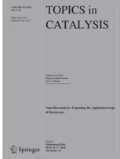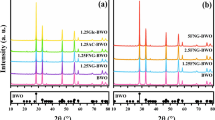Abstract
Photocatalytic degradation of organic dyes in less-toxic products under visible light irradiation is considered a green method which is widely used in this field. In this manuscript, a novel coordination polymer (PUCP1) based hybrid-nanocomposite (PUCP1@rGO) was synthesized. The PUCP1 and nanocomposite were successfully characterized by using various analytical techniques such as SCXRD, FT–IR, PXRD, TGA, FE–SEM, BET and XPS. The PUCP1 exhibits a 2D framework with an uninodal 4-connected net and sql topology. The PUCP1@rGO was applied as a sensitive and selective photocatalyst for significant degradation of Safranin-O (SO) dye. The rGO played an important role in the expansion of photocatalytic activity of the PUCP1 by inhibiting the recombination probability of electron–hole pairs. The results revealed that PUCP1@rGO nanocomposite can degrade 76% of SO dye in only 90 min under visible light at a neutral pH. The PUCP1@rGO was found very sensitive to photocatalytic degradation of SO dye because a very small amount of catalyst (i.e. 10 mg) degrades the 5 μM concentration of SO dye in the presence of light. The PUCP1@rGO is a reusable photocatalyst for up to 5 cycles. Rarely, any sensitive photocatalyst for SO dye is reported in literature than PUCP1@rGO which degrades SO dye in a very small period with significant quantity. Thus, PUCP1@rGO can be used as a promising photocatalyst for the degradation of SO dye.
Graphical Abstract
In this work, we have synthesized a novel coordination polymer (PUCP1) and nanocomposite (PUCP1@rGO) by impreganation of rGO in PUCP1 framework.The PUCP1 exhibited selective photocatalytic response towards safranin-O dye under visible light irradiation and impregnation of rGO enhance the photocatalytic properties of PUCP1@rGO nanocomposite as compared to parent PUCP1.The PUCP1@rGO nanocomposite degrade the safranin-O dye up to 76% in 90 min only under visible light.









Similar content being viewed by others
References
Nazri MKHM, Sapawe N (2020) A short review on photocatalytic toward dye degradation. Mater Today Proc 31:A42–A47. https://doi.org/10.1016/j.matpr.2020.10.967
Dehghani M, Nadeem H, Raghuwanshi VS et al (2020) ZnO/cellulose nanofiber composites for sustainable sunlight-driven dye degradation. ACS Appl Nano Mater 3:10284–10295. https://doi.org/10.1021/acsanm.0c02199
Al-Tohamy R, Ali SS, Li F et al (2022) A critical review on the treatment of dye-containing wastewater: ecotoxicological and health concerns of textile dyes and possible remediation approaches for environmental safety. Ecotoxicol Environ Saf 231:113160. https://doi.org/10.1016/j.ecoenv.2021.113160
Rafiq A, Ikram M, Ali S et al (2021) Photocatalytic degradation of dyes using semiconductor photocatalysts to clean industrial water pollution. J Ind Eng Chem 97:111–128. https://doi.org/10.1016/j.jiec.2021.02.017
Njuguna DG, Schönherr H (2021) Xanthan gum hydrogels as high-capacity adsorbents for dye removal. ACS Appl Polym Mater 3:3142–3152. https://doi.org/10.1021/acsapm.1c00343
Kirandeep S, Sharma A et al (2021) Synthesis and characterization of 1D-Co/Zn MOFs having potential for efficient dye adsorption from wastewater. J Mol Struct 1226:129327. https://doi.org/10.1016/j.molstruc.2020.129327
Wang Y, Geng Q, Yang J et al (2020) Hybrid system of flocculation-photocatalysis for the decolorization of crystal violet, reactive red X-3B, and acid orange II dye. ACS Omega 5:31137–31145. https://doi.org/10.1021/acsomega.0c04285
Zheng X, Cheng H, Yang J et al (2018) One-pot solvothermal preparation of Fe3O4-urushiol-graphene hybrid nanocomposites for highly improved fenton reactions. ACS Appl Nano Mater 1:2754–2762. https://doi.org/10.1021/acsanm.8b00446
Gholami Derami H, Gupta P, Gupta R et al (2020) Palladium nanoparticle-decorated mesoporous polydopamine/bacterial nanocellulose as a catalytically active universal dye removal ultrafiltration membrane. ACS Appl Nano Mater 3:5437–5448. https://doi.org/10.1021/acsanm.0c00787
Kotal M, Sharma A, Jakhar S et al (2020) Graphenelated cobalt nanoparticle embedded nitrogen-doped carbon nanotubes for efficient visible-light photocatalysis. Cryst Growth Des 20:4627–4639. https://doi.org/10.1021/acs.cgd.0c00430
Ajmal A, Majeed I, Malik RN et al (2014) Principles and mechanisms of photocatalytic dye degradation on tio 2 based photocatalysts: a comparative overview. RSC Adv 4:37003–37026. https://doi.org/10.1039/c4ra06658h
Lee SY, Kang D, Jeong S et al (2020) Photocatalytic degradation of rhodamine b dye by TiO2 and gold nanoparticles supported on a floating porous polydimethylsiloxane sponge under ultraviolet and visible light irradiation. ACS Omega 5:4233–4241. https://doi.org/10.1021/acsomega.9b04127
Wen T, Zhang DX, Zhang J (2013) Two-dimensional copper(I) coordination polymer materials as photocatalysts for the degradation of organic dyes. Inorg Chem 52:12–14. https://doi.org/10.1021/ic302273h
Kumar A, Sahoo SC, Mehta SK et al (2022) A luminescent Zn-MOF for the detection of explosives and development of fingerprints. Anal Methods 14:700–707. https://doi.org/10.1039/d1ay01977e
Kirandeep KA, Sharma A et al (2021) Metal organic framework as “turn-on” fluorescent sensor for Zr(IV) ions and selective adsorbent for organic dyes. Microchem J 171:106824. https://doi.org/10.1016/j.microc.2021.106824
Zhang J, Sun L, Xu F et al (2012) Hydrogen storage and selective carbon dioxide capture in a new chromium(III)-based infinite coordination polymer. RSC Adv 2:2939–2945. https://doi.org/10.1039/c2ra01188c
Hasegawa S, Horike S, Matsuda R et al (2007) Three-dimensional porous coordination polymer functionalized with amide groups based on tridentate ligand: selective sorption and catalysis. J Am Chem Soc 129:2607–2614. https://doi.org/10.1021/ja067374y
Dutta S, Chakraborty S, Drew MGB et al (2019) Two geometrical isomers of a 1d coordination polymer: rationalization by theoretical calculations and variation of electrical properties with the change in binding mode of dicarboxylate linker. Cryst Growth Des 19:5819–5828. https://doi.org/10.1021/acs.cgd.9b00849
Shu Y, Ye Q, Dai T et al (2021) Encapsulation of luminescent guests to construct luminescent metal-organic frameworks for chemical sensing. ACS Sens 6:641–658. https://doi.org/10.1021/acssensors.0c02562
Qian W, Zhao K, Zhang D et al (2019) Piezoelectric material-polymer composite porous foam for efficient dye degradation via the piezo-catalytic effect. ACS Appl Mater Interfaces 11:27862–27869. https://doi.org/10.1021/acsami.9b07857
Nguyen MB, Le GH, Nguyen TD et al (2021) Bimetallic Ag–Zn–BTC/GO composite as highly efficient photocatalyst in the photocatalytic degradation of reactive yellow 145 dye in water. J Hazard Mater 420:126560. https://doi.org/10.1016/j.jhazmat.2021.126560
Tarcan R, Todor-Boer O, Petrovai I et al (2020) Reduced graphene oxide today. J Mater Chem C 8:1198–1224. https://doi.org/10.1039/c9tc04916a
Qujiao, Huang L jun, Han Z yang, H et al (2021) A review of graphene–oxide/metal–organic framework composites materials: characteristics, preparation and applications. J Porous Mater 28:1837–1865. https://doi.org/10.1007/s10934-021-01125-w
Singh MK, Gupta AK, Krishnan S et al (2021) A new hierarchically porous Cu-MOF composited with rgo as an efficient hybrid supercapacitor electrode material. J Energy Storage 43:103301. https://doi.org/10.1016/j.est.2021.103301
Chen Y, Zhai B, Liang Y (2019) Enhanced degradation performance of organic dyes removal by semiconductor/MOF/graphene oxide composites under visible light irradiation. Diam Relat Mater 98:107508. https://doi.org/10.1016/j.diamond.2019.107508
Gao H, Ma Y, Li Y et al (2021) MOF-derived N-doped carbon coated Co/RGO composites with enhanced electrocatalytic activity for oxygen reduction reaction. Inorg Chem Commun 123:108330. https://doi.org/10.1016/j.inoche.2020.108330
Vu HT, Nguyen MB, Vu TM et al (2020) Synthesis and application of novel nano Fe-BTC/GO composites as highly efficient photocatalysts in the dye degradation. Top Catal 63:1046–1055. https://doi.org/10.1007/s11244-020-01289-w
Tang B, Dai Y, Sun Y et al (2020) Graphene and MOFs co-modified composites for high adsorption capacity and photocatalytic performance to remove pollutant under both UV- and visible-light irradiation. J Solid State Chem 284:121215. https://doi.org/10.1016/j.jssc.2020.121215
Kaid MM, Elbanna O, El-Hakam SA et al (2022) Effective photocatalytic degradation of organic dyes using ZNC/rGO nanocomposite photocatalyst derived from ZIF-8/rGO thermolysis for water treatment. J Photochem Photobiol A 430:114001. https://doi.org/10.1016/j.jphotochem.2022.114001
Akbarzadeh E, Soheili HZ, Hosseinifard M, Gholami MR (2020) Preparation and characterization of novel Ag3VO4/Cu-MOF/rGO heterojunction for photocatalytic degradation of organic pollutants. Mater Res Bull 121:110621. https://doi.org/10.1016/j.materresbull.2019.110621
Ramalingam G, Pachaiappan R, Kumar PS et al (2022) Hybrid metal organic frameworks as an exotic material for the photocatalytic degradation of pollutants present in wastewater: a review. Chemosphere 288:132448. https://doi.org/10.1016/j.chemosphere.2021.132448
Mao J, Ge M, Huang J et al (2017) Constructing multifunctional MOF@rGO hydro-/aerogels by the self-assembly process for customized water remediation. J Mater Chem A 5:11873–11881. https://doi.org/10.1039/c7ta01343d
El-Kemary M, Abdel-Moneam Y, Madkour M, El-Mehasseb I (2011) Enhanced photocatalytic degradation of Safranin-O by heterogeneous nanoparticles for environmental applications. J Lumin 131:570–576. https://doi.org/10.1016/j.jlumin.2010.10.025
Abdullah FH, Rauf MA, Ashraf SS (2007) Photolytic oxidation of Safranin-O with H2O2. Dye Pigment 72:349–352. https://doi.org/10.1016/j.dyepig.2005.09.015
Ekka B, Sahu MK, Patel RK, Dash P (2019) Titania coated silica nanocomposite prepared via encapsulation method for the degradation of safranin-O dye from aqueous solution: optimization using statistical design. Water Resour Ind. https://doi.org/10.1016/j.wri.2016.08.001
Hayat K, Gondal MA, Khaled MM et al (2011) Laser induced photocatalytic degradation of hazardous dye (Safranin-O) using self synthesized nanocrystalline WO3. J Hazard Mater 186:1226–1233. https://doi.org/10.1016/j.jhazmat.2010.11.133
El-Kemary M, El-Shamy H (2009) Fluorescence modulation and photodegradation characteristics of safranin O dye in the presence of Zns nanoparticles. J Photochem Photobiol A 205:151–155. https://doi.org/10.1016/j.jphotochem.2009.04.021
CrysAlis PRO (2014) Agilent Technologies Ltd. Yarnton, Oxfordshire
ABSPACK S (2005) An Oxford Diffraction Program. Diffraction, Ltd, UK
Burla MC, Caliandro R, Camalli M et al (2007) IL MILIONE: a suite of computer programs for crystal structure solution of proteins. J Appl Crystallogr 40:609–613
Sheldrick GM, Shelxs AC (2015) Sect. A: Found. Crystallogr., 2008, 64, 112 CrossRef CAS;(b) GM Sheldrick, Shelxl 2014, Crystal structure refinement with SHELXL. Acta Crystallogr Sect C 71:3–8
Lian G, Tuan C, Li L et al (2016) Vertically aligned and interconnected graphene networks for high thermal conductivity of epoxy composites with ultralow loading. Chem Mater. https://doi.org/10.1021/acs.chemmater.6b01595
Kumar A, Sharma A, Chandra S et al (2021) Metal organic framework as “ turn-on ” fluorescent sensor for Zr(IV) ions and selective adsorbent for organic dyes. Microchem J 171:106824. https://doi.org/10.1016/j.microc.2021.106824
Sahoo MK, Samantara AK, Behera JN (2021) Impact of iron in three-dimensional co-mof for electrocatalytic water oxidation. Inorg Chem. https://doi.org/10.1021/acs.inorgchem.1c01857
Lin L, Huang S, Zhu Y et al (2019) Construction of CdS/MoS2 heterojunction from core-shell mos 2 @Cd-MOF for efficient photocatalytic hydrogen evolution. Dalt Trans 48:2715–2721. https://doi.org/10.1039/c8dt04745f
Bensalah J, Habsaoui A, Dagdag O et al (2021) Adsorption of a cationic dye (safranin) by artificial cationic resins Amberlite®IRC-50: equilibrium, kinetic and thermodynamic study. Chem Data Collect 35:100756. https://doi.org/10.1016/j.cdc.2021.100756
Kaur R, Kaur A, Umar A et al (2019) Metal organic framework (MOF) porous octahedral nanocrystals of Cu-BTC: synthesis, properties and enhanced absorption properties. Mater Res Bull 109:124–133. https://doi.org/10.1016/j.materresbull.2018.07.025
Lamba R, Umar A, Mehta SK, Kansal SK (2015) CeO2ZnO hexagonal nanodisks: efficient material for the degradation of direct blue 15 dye and its simulated dye bath effluent under solar light. J Alloys Compd 620:67–73. https://doi.org/10.1016/j.jallcom.2014.09.101
Funding
Ajay Kumar is thankful to CSIR, India for financial support as SRF {09/135(0847)/2019-EMR-I}. Kushal Arya also thanks CSIR for SRF {09/135(0892)/2019-EMR-I}. Authors thanks DST, GOI for financial support in the form of PURSE Grant (II) and FIST (II) for the Single-crystal facility at the Department of Chemistry, Panjab University, Chandigarh.
Author information
Authors and Affiliations
Corresponding author
Ethics declarations
Conflict of interest
The authors declare no competing financial interest.
Additional information
Publisher's Note
Springer Nature remains neutral with regard to jurisdictional claims in published maps and institutional affiliations.
Supplementary Information
Below is the link to the electronic supplementary material.
Rights and permissions
Springer Nature or its licensor holds exclusive rights to this article under a publishing agreement with the author(s) or other rightsholder(s); author self-archiving of the accepted manuscript version of this article is solely governed by the terms of such publishing agreement and applicable law.
About this article
Cite this article
Arya, K., Kumar, A., Sharma, A. et al. A Hybrid Nanocomposite of Coordination Polymer and rGO for Photocatalytic Degradation of Safranin-O Dye Under Visible Light Irradiation. Top Catal 65, 1924–1937 (2022). https://doi.org/10.1007/s11244-022-01701-7
Accepted:
Published:
Issue Date:
DOI: https://doi.org/10.1007/s11244-022-01701-7




